Analysing Negligence: A Tort Law Case Study in Australian Construction
VerifiedAdded on 2023/03/30
|8
|1282
|390
Case Study
AI Summary
This case study addresses questions related to negligence under Tort Law, applying it to provided case articles. It discusses the aims of Civil Law, defines Tort Law, and outlines the elements required to establish liability for negligence with reference to case authorities. The analysis identifies potential defendants and plaintiffs in a negligence action, examines the establishment of negligence elements against a single defendant, and determines the liability when multiple defendants are involved. Finally, the study discusses the consequences of holding a defendant liable for negligence, providing a comprehensive overview of the legal principles and their practical application within the context of construction site safety.
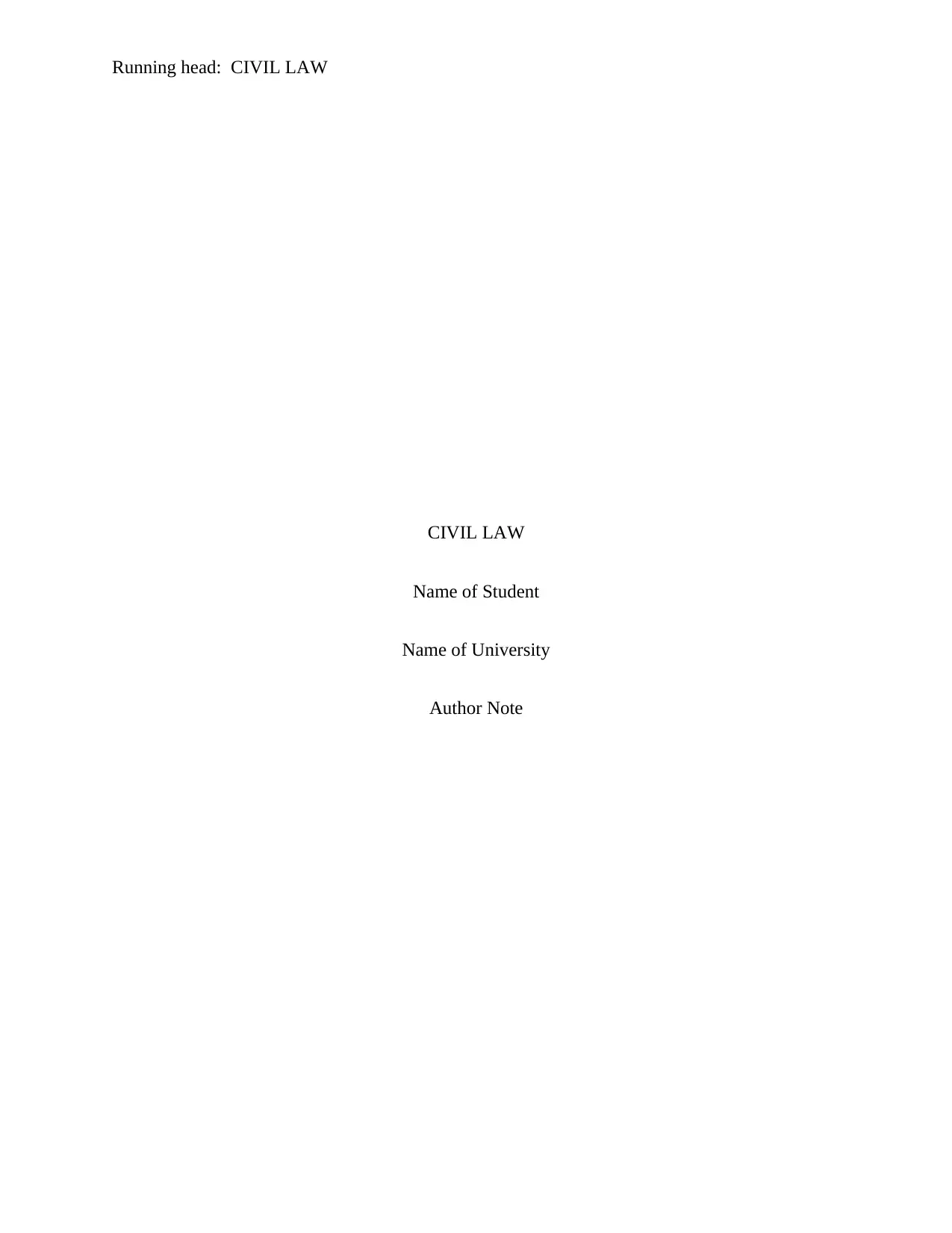
Running head: CIVIL LAW
CIVIL LAW
Name of Student
Name of University
Author Note
CIVIL LAW
Name of Student
Name of University
Author Note
Paraphrase This Document
Need a fresh take? Get an instant paraphrase of this document with our AI Paraphraser
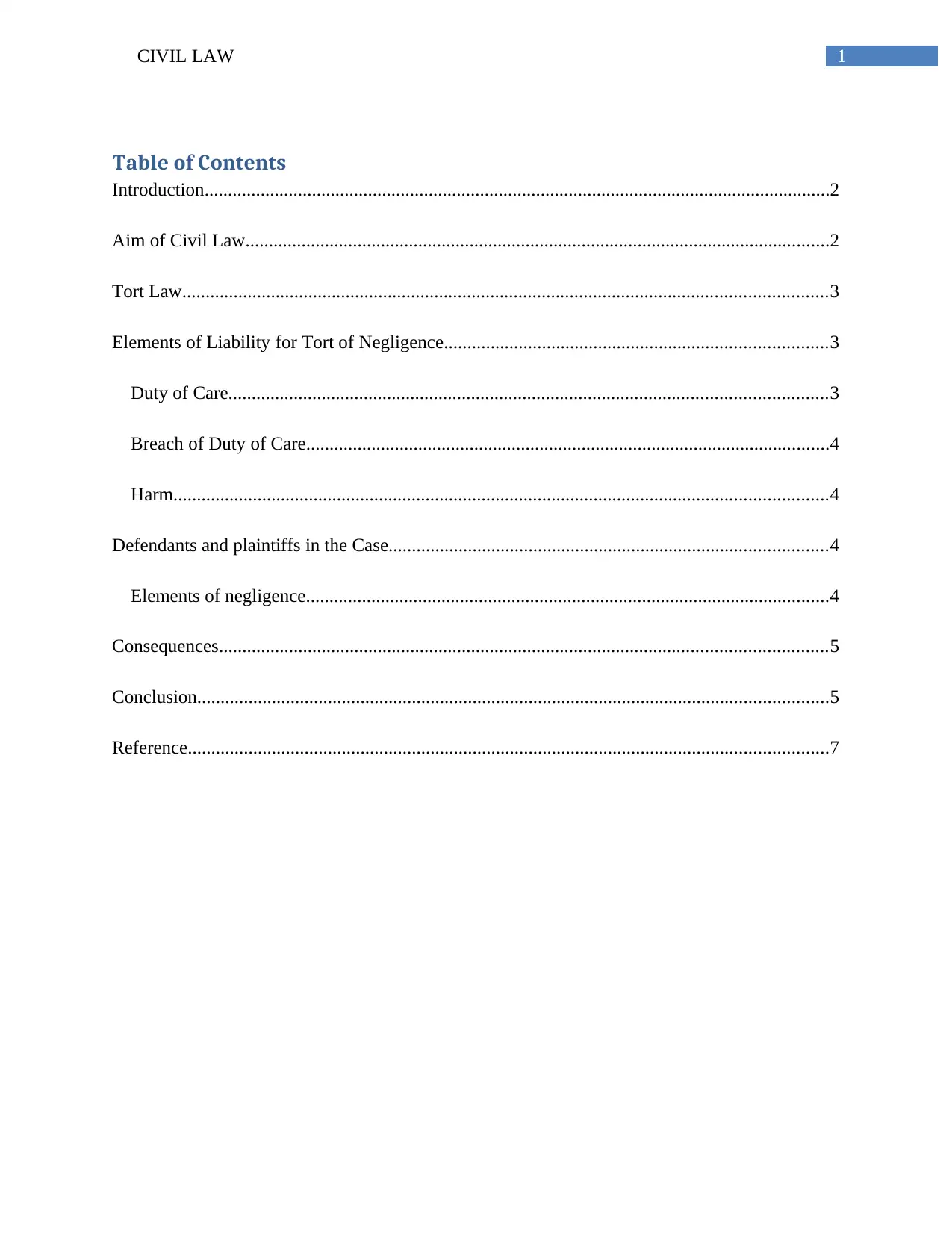
1CIVIL LAW
Table of Contents
Introduction......................................................................................................................................2
Aim of Civil Law.............................................................................................................................2
Tort Law..........................................................................................................................................3
Elements of Liability for Tort of Negligence..................................................................................3
Duty of Care................................................................................................................................3
Breach of Duty of Care................................................................................................................4
Harm............................................................................................................................................4
Defendants and plaintiffs in the Case..............................................................................................4
Elements of negligence................................................................................................................4
Consequences..................................................................................................................................5
Conclusion.......................................................................................................................................5
Reference.........................................................................................................................................7
Table of Contents
Introduction......................................................................................................................................2
Aim of Civil Law.............................................................................................................................2
Tort Law..........................................................................................................................................3
Elements of Liability for Tort of Negligence..................................................................................3
Duty of Care................................................................................................................................3
Breach of Duty of Care................................................................................................................4
Harm............................................................................................................................................4
Defendants and plaintiffs in the Case..............................................................................................4
Elements of negligence................................................................................................................4
Consequences..................................................................................................................................5
Conclusion.......................................................................................................................................5
Reference.........................................................................................................................................7
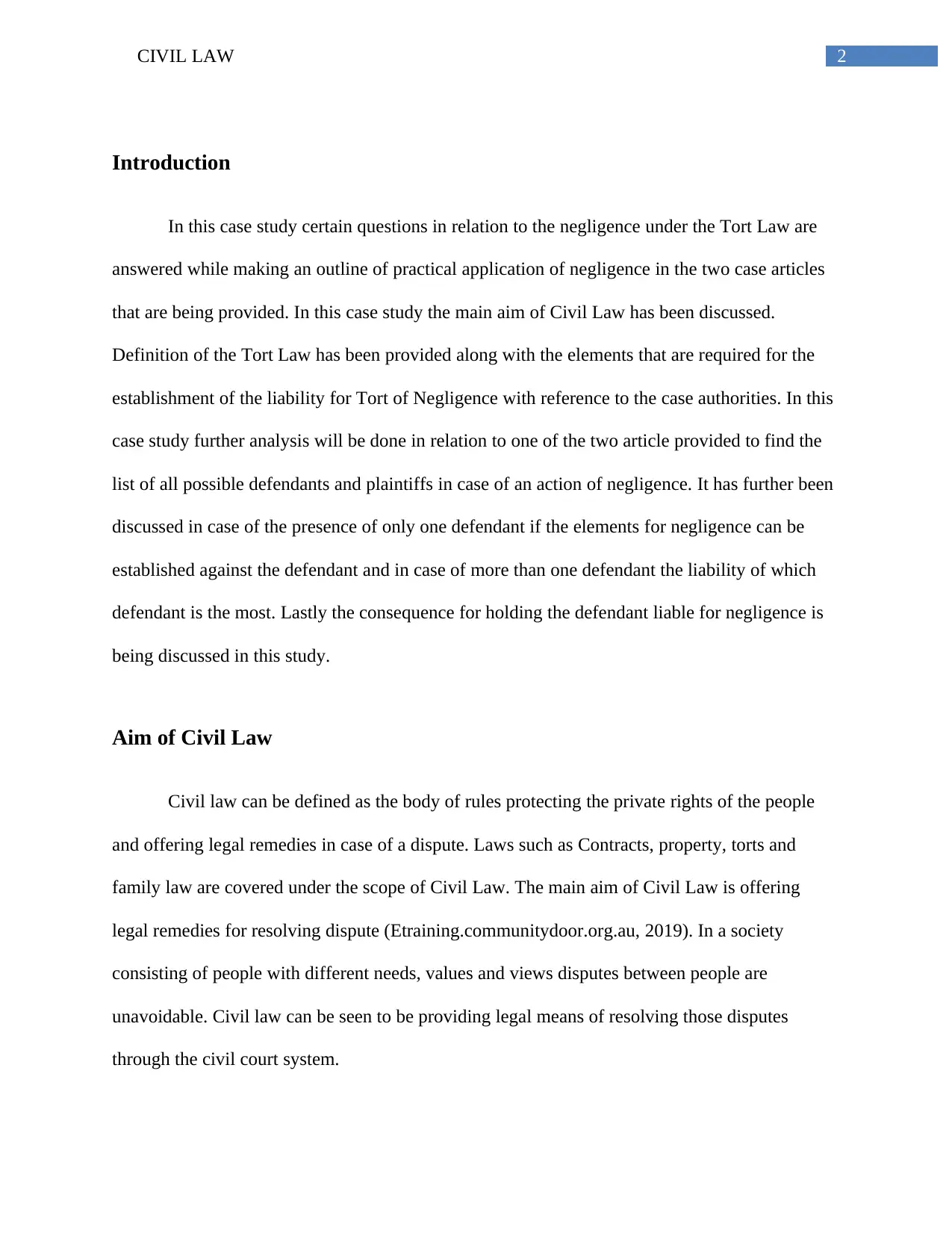
2CIVIL LAW
Introduction
In this case study certain questions in relation to the negligence under the Tort Law are
answered while making an outline of practical application of negligence in the two case articles
that are being provided. In this case study the main aim of Civil Law has been discussed.
Definition of the Tort Law has been provided along with the elements that are required for the
establishment of the liability for Tort of Negligence with reference to the case authorities. In this
case study further analysis will be done in relation to one of the two article provided to find the
list of all possible defendants and plaintiffs in case of an action of negligence. It has further been
discussed in case of the presence of only one defendant if the elements for negligence can be
established against the defendant and in case of more than one defendant the liability of which
defendant is the most. Lastly the consequence for holding the defendant liable for negligence is
being discussed in this study.
Aim of Civil Law
Civil law can be defined as the body of rules protecting the private rights of the people
and offering legal remedies in case of a dispute. Laws such as Contracts, property, torts and
family law are covered under the scope of Civil Law. The main aim of Civil Law is offering
legal remedies for resolving dispute (Etraining.communitydoor.org.au, 2019). In a society
consisting of people with different needs, values and views disputes between people are
unavoidable. Civil law can be seen to be providing legal means of resolving those disputes
through the civil court system.
Introduction
In this case study certain questions in relation to the negligence under the Tort Law are
answered while making an outline of practical application of negligence in the two case articles
that are being provided. In this case study the main aim of Civil Law has been discussed.
Definition of the Tort Law has been provided along with the elements that are required for the
establishment of the liability for Tort of Negligence with reference to the case authorities. In this
case study further analysis will be done in relation to one of the two article provided to find the
list of all possible defendants and plaintiffs in case of an action of negligence. It has further been
discussed in case of the presence of only one defendant if the elements for negligence can be
established against the defendant and in case of more than one defendant the liability of which
defendant is the most. Lastly the consequence for holding the defendant liable for negligence is
being discussed in this study.
Aim of Civil Law
Civil law can be defined as the body of rules protecting the private rights of the people
and offering legal remedies in case of a dispute. Laws such as Contracts, property, torts and
family law are covered under the scope of Civil Law. The main aim of Civil Law is offering
legal remedies for resolving dispute (Etraining.communitydoor.org.au, 2019). In a society
consisting of people with different needs, values and views disputes between people are
unavoidable. Civil law can be seen to be providing legal means of resolving those disputes
through the civil court system.
⊘ This is a preview!⊘
Do you want full access?
Subscribe today to unlock all pages.

Trusted by 1+ million students worldwide
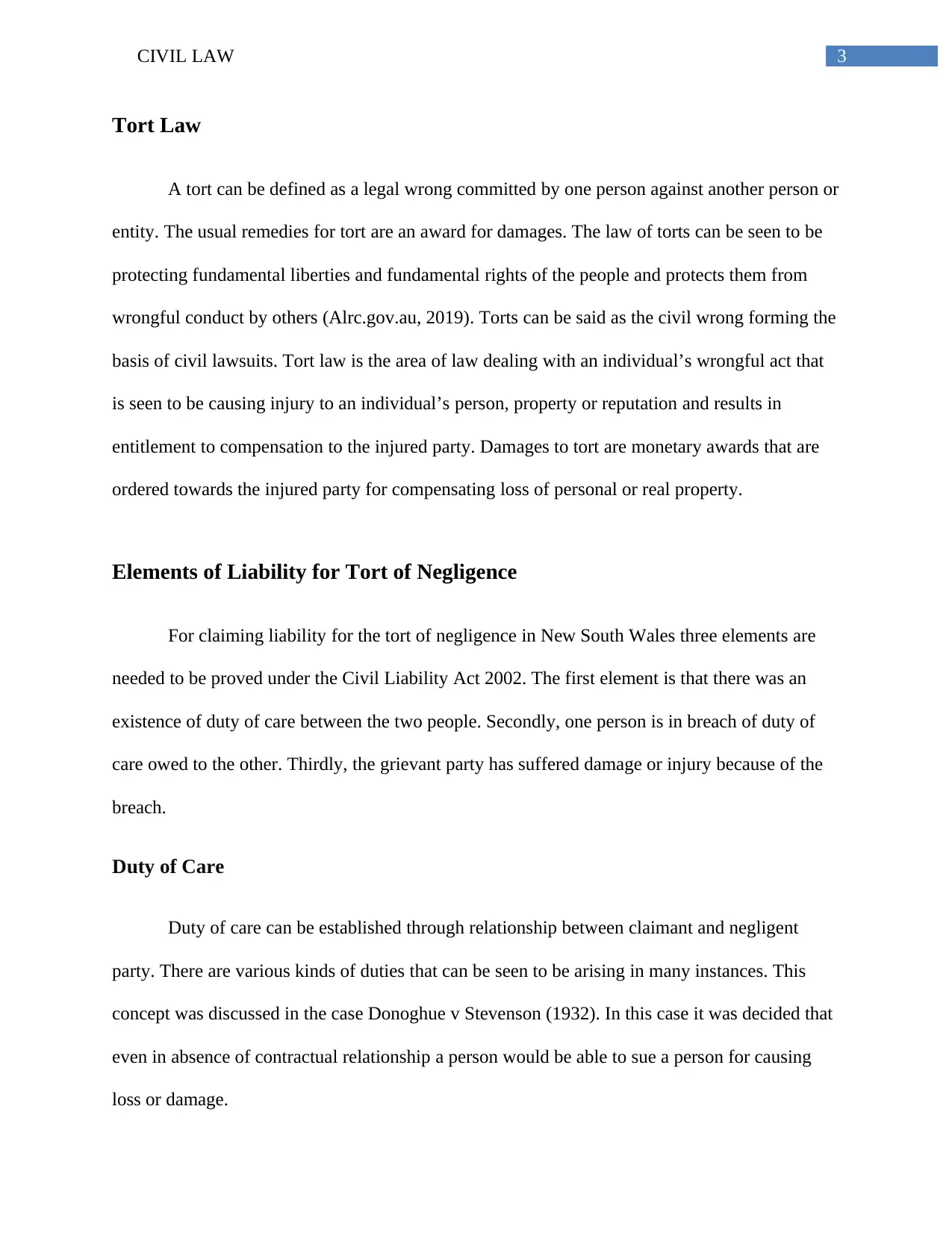
3CIVIL LAW
Tort Law
A tort can be defined as a legal wrong committed by one person against another person or
entity. The usual remedies for tort are an award for damages. The law of torts can be seen to be
protecting fundamental liberties and fundamental rights of the people and protects them from
wrongful conduct by others (Alrc.gov.au, 2019). Torts can be said as the civil wrong forming the
basis of civil lawsuits. Tort law is the area of law dealing with an individual’s wrongful act that
is seen to be causing injury to an individual’s person, property or reputation and results in
entitlement to compensation to the injured party. Damages to tort are monetary awards that are
ordered towards the injured party for compensating loss of personal or real property.
Elements of Liability for Tort of Negligence
For claiming liability for the tort of negligence in New South Wales three elements are
needed to be proved under the Civil Liability Act 2002. The first element is that there was an
existence of duty of care between the two people. Secondly, one person is in breach of duty of
care owed to the other. Thirdly, the grievant party has suffered damage or injury because of the
breach.
Duty of Care
Duty of care can be established through relationship between claimant and negligent
party. There are various kinds of duties that can be seen to be arising in many instances. This
concept was discussed in the case Donoghue v Stevenson (1932). In this case it was decided that
even in absence of contractual relationship a person would be able to sue a person for causing
loss or damage.
Tort Law
A tort can be defined as a legal wrong committed by one person against another person or
entity. The usual remedies for tort are an award for damages. The law of torts can be seen to be
protecting fundamental liberties and fundamental rights of the people and protects them from
wrongful conduct by others (Alrc.gov.au, 2019). Torts can be said as the civil wrong forming the
basis of civil lawsuits. Tort law is the area of law dealing with an individual’s wrongful act that
is seen to be causing injury to an individual’s person, property or reputation and results in
entitlement to compensation to the injured party. Damages to tort are monetary awards that are
ordered towards the injured party for compensating loss of personal or real property.
Elements of Liability for Tort of Negligence
For claiming liability for the tort of negligence in New South Wales three elements are
needed to be proved under the Civil Liability Act 2002. The first element is that there was an
existence of duty of care between the two people. Secondly, one person is in breach of duty of
care owed to the other. Thirdly, the grievant party has suffered damage or injury because of the
breach.
Duty of Care
Duty of care can be established through relationship between claimant and negligent
party. There are various kinds of duties that can be seen to be arising in many instances. This
concept was discussed in the case Donoghue v Stevenson (1932). In this case it was decided that
even in absence of contractual relationship a person would be able to sue a person for causing
loss or damage.
Paraphrase This Document
Need a fresh take? Get an instant paraphrase of this document with our AI Paraphraser
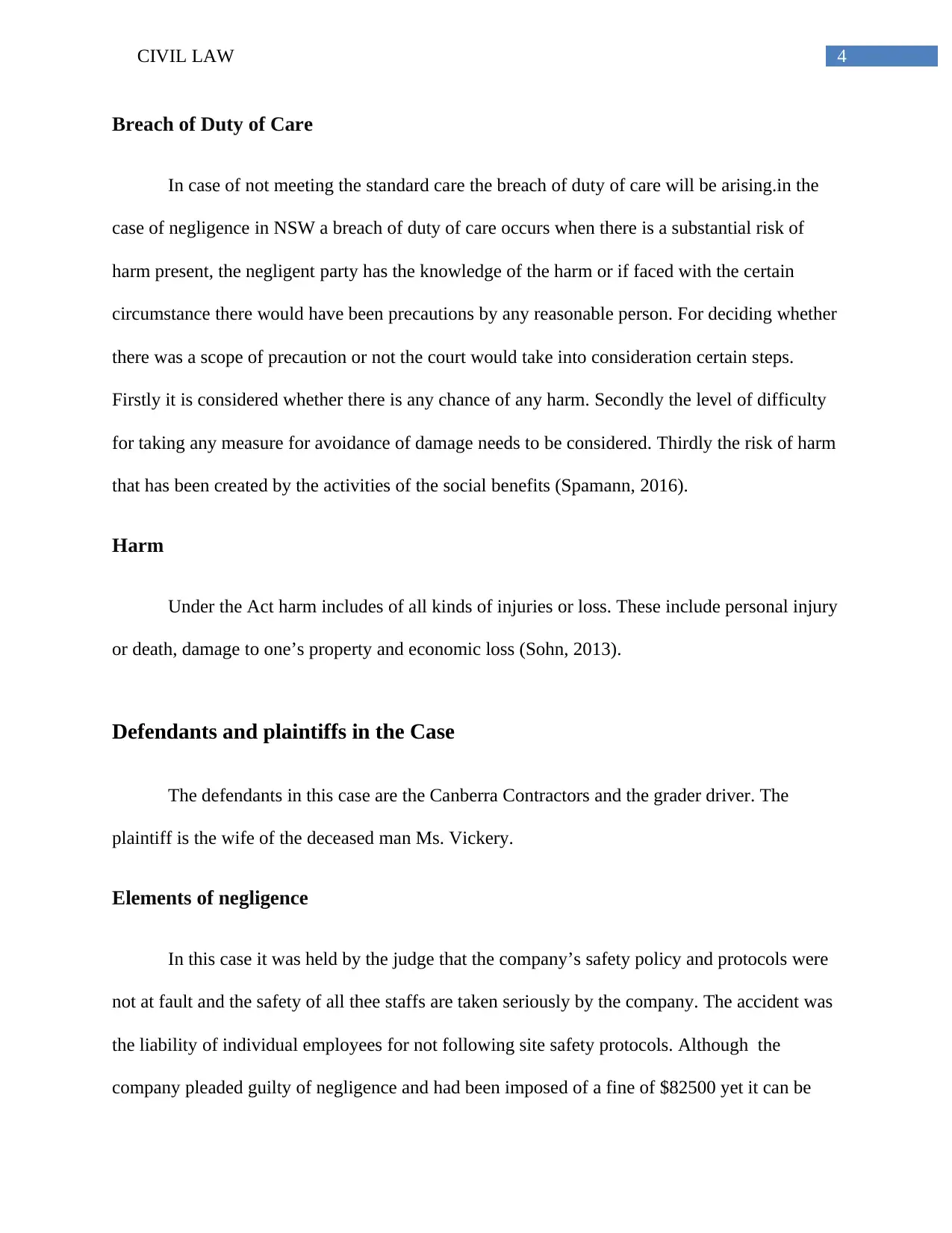
4CIVIL LAW
Breach of Duty of Care
In case of not meeting the standard care the breach of duty of care will be arising.in the
case of negligence in NSW a breach of duty of care occurs when there is a substantial risk of
harm present, the negligent party has the knowledge of the harm or if faced with the certain
circumstance there would have been precautions by any reasonable person. For deciding whether
there was a scope of precaution or not the court would take into consideration certain steps.
Firstly it is considered whether there is any chance of any harm. Secondly the level of difficulty
for taking any measure for avoidance of damage needs to be considered. Thirdly the risk of harm
that has been created by the activities of the social benefits (Spamann, 2016).
Harm
Under the Act harm includes of all kinds of injuries or loss. These include personal injury
or death, damage to one’s property and economic loss (Sohn, 2013).
Defendants and plaintiffs in the Case
The defendants in this case are the Canberra Contractors and the grader driver. The
plaintiff is the wife of the deceased man Ms. Vickery.
Elements of negligence
In this case it was held by the judge that the company’s safety policy and protocols were
not at fault and the safety of all thee staffs are taken seriously by the company. The accident was
the liability of individual employees for not following site safety protocols. Although the
company pleaded guilty of negligence and had been imposed of a fine of $82500 yet it can be
Breach of Duty of Care
In case of not meeting the standard care the breach of duty of care will be arising.in the
case of negligence in NSW a breach of duty of care occurs when there is a substantial risk of
harm present, the negligent party has the knowledge of the harm or if faced with the certain
circumstance there would have been precautions by any reasonable person. For deciding whether
there was a scope of precaution or not the court would take into consideration certain steps.
Firstly it is considered whether there is any chance of any harm. Secondly the level of difficulty
for taking any measure for avoidance of damage needs to be considered. Thirdly the risk of harm
that has been created by the activities of the social benefits (Spamann, 2016).
Harm
Under the Act harm includes of all kinds of injuries or loss. These include personal injury
or death, damage to one’s property and economic loss (Sohn, 2013).
Defendants and plaintiffs in the Case
The defendants in this case are the Canberra Contractors and the grader driver. The
plaintiff is the wife of the deceased man Ms. Vickery.
Elements of negligence
In this case it was held by the judge that the company’s safety policy and protocols were
not at fault and the safety of all thee staffs are taken seriously by the company. The accident was
the liability of individual employees for not following site safety protocols. Although the
company pleaded guilty of negligence and had been imposed of a fine of $82500 yet it can be
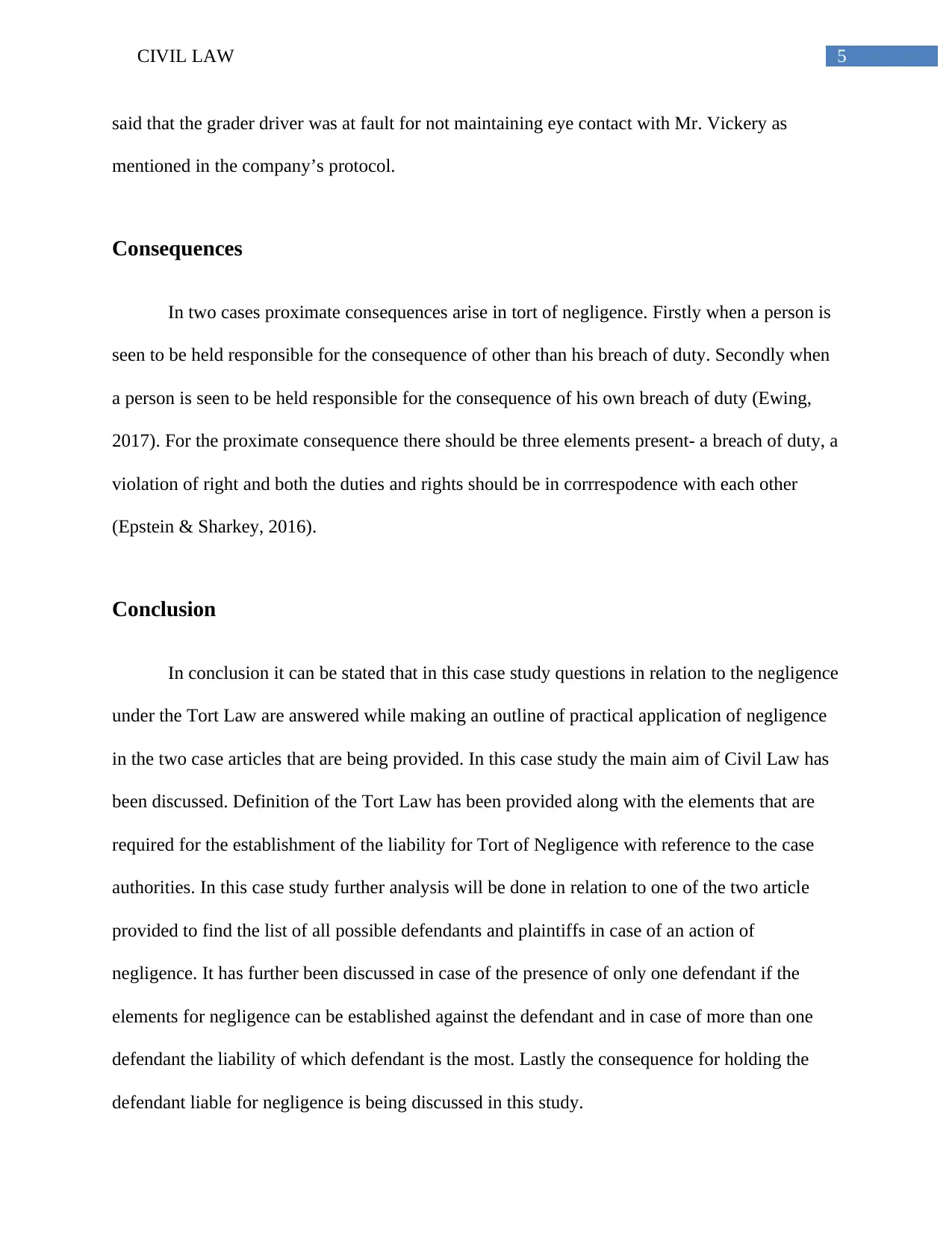
5CIVIL LAW
said that the grader driver was at fault for not maintaining eye contact with Mr. Vickery as
mentioned in the company’s protocol.
Consequences
In two cases proximate consequences arise in tort of negligence. Firstly when a person is
seen to be held responsible for the consequence of other than his breach of duty. Secondly when
a person is seen to be held responsible for the consequence of his own breach of duty (Ewing,
2017). For the proximate consequence there should be three elements present- a breach of duty, a
violation of right and both the duties and rights should be in corrrespodence with each other
(Epstein & Sharkey, 2016).
Conclusion
In conclusion it can be stated that in this case study questions in relation to the negligence
under the Tort Law are answered while making an outline of practical application of negligence
in the two case articles that are being provided. In this case study the main aim of Civil Law has
been discussed. Definition of the Tort Law has been provided along with the elements that are
required for the establishment of the liability for Tort of Negligence with reference to the case
authorities. In this case study further analysis will be done in relation to one of the two article
provided to find the list of all possible defendants and plaintiffs in case of an action of
negligence. It has further been discussed in case of the presence of only one defendant if the
elements for negligence can be established against the defendant and in case of more than one
defendant the liability of which defendant is the most. Lastly the consequence for holding the
defendant liable for negligence is being discussed in this study.
said that the grader driver was at fault for not maintaining eye contact with Mr. Vickery as
mentioned in the company’s protocol.
Consequences
In two cases proximate consequences arise in tort of negligence. Firstly when a person is
seen to be held responsible for the consequence of other than his breach of duty. Secondly when
a person is seen to be held responsible for the consequence of his own breach of duty (Ewing,
2017). For the proximate consequence there should be three elements present- a breach of duty, a
violation of right and both the duties and rights should be in corrrespodence with each other
(Epstein & Sharkey, 2016).
Conclusion
In conclusion it can be stated that in this case study questions in relation to the negligence
under the Tort Law are answered while making an outline of practical application of negligence
in the two case articles that are being provided. In this case study the main aim of Civil Law has
been discussed. Definition of the Tort Law has been provided along with the elements that are
required for the establishment of the liability for Tort of Negligence with reference to the case
authorities. In this case study further analysis will be done in relation to one of the two article
provided to find the list of all possible defendants and plaintiffs in case of an action of
negligence. It has further been discussed in case of the presence of only one defendant if the
elements for negligence can be established against the defendant and in case of more than one
defendant the liability of which defendant is the most. Lastly the consequence for holding the
defendant liable for negligence is being discussed in this study.
⊘ This is a preview!⊘
Do you want full access?
Subscribe today to unlock all pages.

Trusted by 1+ million students worldwide

6CIVIL LAW
Paraphrase This Document
Need a fresh take? Get an instant paraphrase of this document with our AI Paraphraser
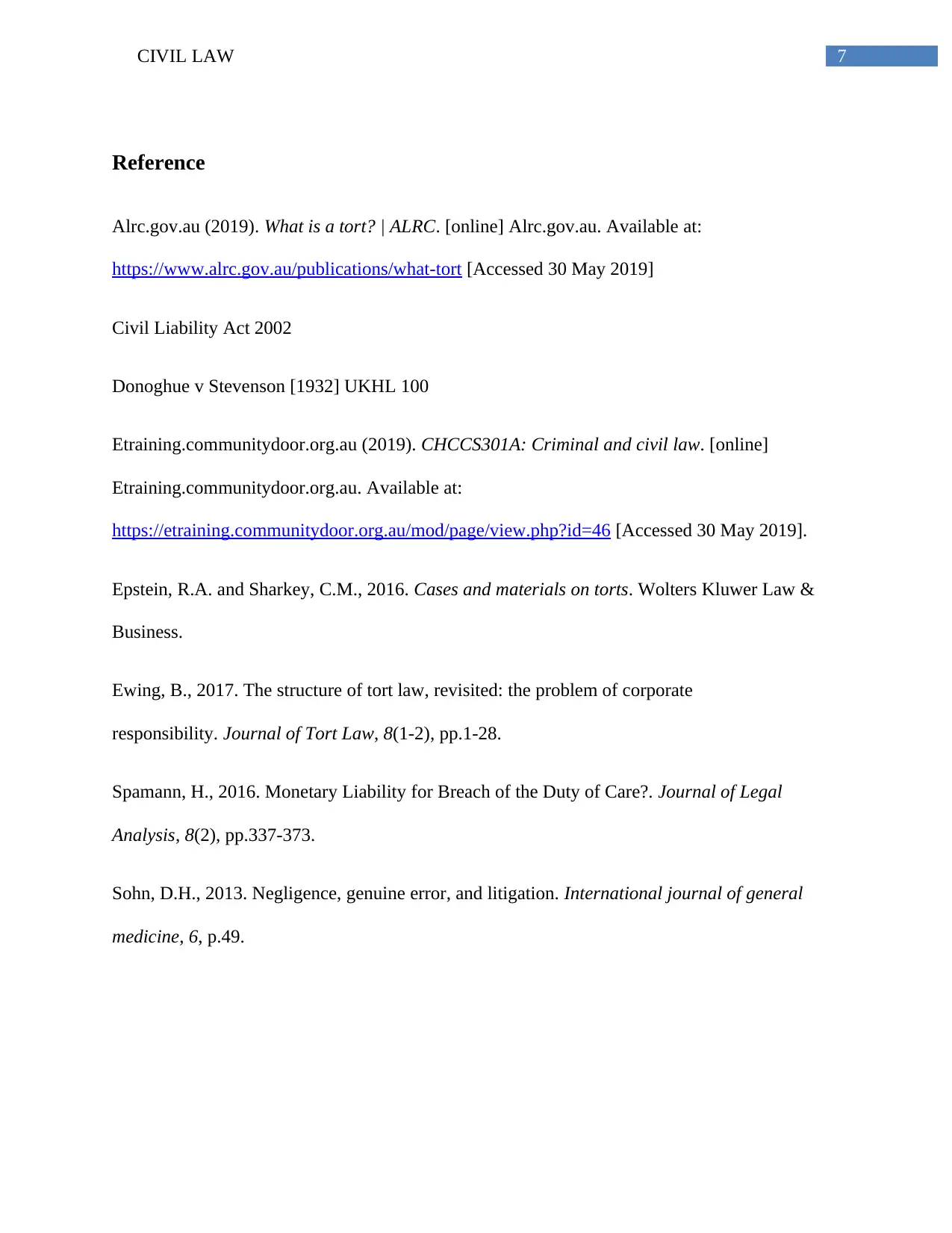
7CIVIL LAW
Reference
Alrc.gov.au (2019). What is a tort? | ALRC. [online] Alrc.gov.au. Available at:
https://www.alrc.gov.au/publications/what-tort [Accessed 30 May 2019]
Civil Liability Act 2002
Donoghue v Stevenson [1932] UKHL 100
Etraining.communitydoor.org.au (2019). CHCCS301A: Criminal and civil law. [online]
Etraining.communitydoor.org.au. Available at:
https://etraining.communitydoor.org.au/mod/page/view.php?id=46 [Accessed 30 May 2019].
Epstein, R.A. and Sharkey, C.M., 2016. Cases and materials on torts. Wolters Kluwer Law &
Business.
Ewing, B., 2017. The structure of tort law, revisited: the problem of corporate
responsibility. Journal of Tort Law, 8(1-2), pp.1-28.
Spamann, H., 2016. Monetary Liability for Breach of the Duty of Care?. Journal of Legal
Analysis, 8(2), pp.337-373.
Sohn, D.H., 2013. Negligence, genuine error, and litigation. International journal of general
medicine, 6, p.49.
Reference
Alrc.gov.au (2019). What is a tort? | ALRC. [online] Alrc.gov.au. Available at:
https://www.alrc.gov.au/publications/what-tort [Accessed 30 May 2019]
Civil Liability Act 2002
Donoghue v Stevenson [1932] UKHL 100
Etraining.communitydoor.org.au (2019). CHCCS301A: Criminal and civil law. [online]
Etraining.communitydoor.org.au. Available at:
https://etraining.communitydoor.org.au/mod/page/view.php?id=46 [Accessed 30 May 2019].
Epstein, R.A. and Sharkey, C.M., 2016. Cases and materials on torts. Wolters Kluwer Law &
Business.
Ewing, B., 2017. The structure of tort law, revisited: the problem of corporate
responsibility. Journal of Tort Law, 8(1-2), pp.1-28.
Spamann, H., 2016. Monetary Liability for Breach of the Duty of Care?. Journal of Legal
Analysis, 8(2), pp.337-373.
Sohn, D.H., 2013. Negligence, genuine error, and litigation. International journal of general
medicine, 6, p.49.
1 out of 8
Related Documents
Your All-in-One AI-Powered Toolkit for Academic Success.
+13062052269
info@desklib.com
Available 24*7 on WhatsApp / Email
![[object Object]](/_next/static/media/star-bottom.7253800d.svg)
Unlock your academic potential
Copyright © 2020–2025 A2Z Services. All Rights Reserved. Developed and managed by ZUCOL.



